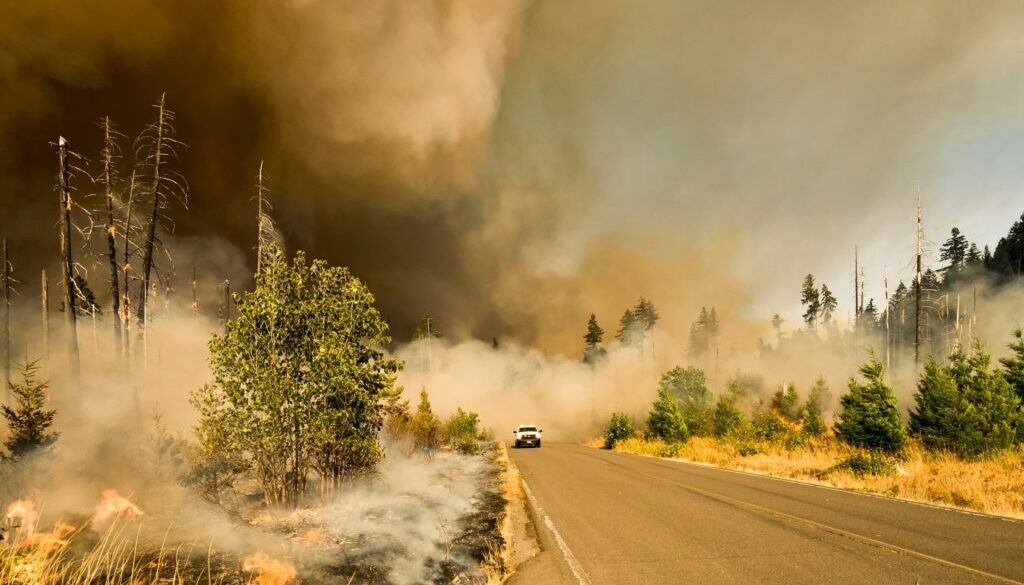Annual climate change report finds “planet on the brink”
Listen to the audio version of this article (generated by AI).
Earth’s vital signs are “flashing red,” fossil fuel use is at peak levels and warming is increasingly impacting forests, oceans and disaster frequency, according to a new report.
The annual “State of the Climate” report, led by the Potsdam Institute for Climate Impact Research and Oregon State University, was published today in the Biosphere journal and paints a dire picture. It finds 22 of the planet’s 34 key vital signs — such as forest loss, energy consumption, greenhouse gas emissions, fossil fuel subsidies and meat production — are at record levels or trending in the wrong direction. It also points out that 2024 was officially the hottest year on record and likely the hottest in the last 125,000 years.
“We are hurtling toward climate chaos. The consequences of human-driven alterations of the climate are no longer future threats but are here now,” the authors wrote. “The window to prevent the worst outcomes is rapidly closing.”
“We are hurtling toward climate chaos.” – State of the Climate report
In addition to global temperatures, the report finds several other troubling climate-related records broken. For example, tree cover loss due to wildfires reached an all-time high in 2024, with fires in tropical forests alone up 370% over 2023. Atmospheric carbon dioxide is at a record level in 2025 so far. In addition, the total thermal energy stored in oceans is at record highs and contributed to the largest coral bleaching event ever recorded that took place from January 2023 to April 2025 and affected 84% of the world’s coral reefs.
Sea ice is rapidly melting and the report finds ice masses in Greenland and Antarctica are at record lows and “may be passing tipping points, potentially committing the planet to meters of sea-level rise,” according to the report.
“The last few years have seen vital signs breaking their records by extraordinary margins, like surface temperature, ocean heat content, sea ice loss and fire-related tree cover loss,” said Johan Rockström, Potsdam Institute for Climate Impact Research director and co-author of the report, in a statement.
The impacts go beyond ecosystems: the costs of climate-linked natural disasters since 2000 reached more than $18 trillion globally.
Fossil fuel use
Much of the record-breaking environmental impacts are driven by record-breaking human activities as the population soars to over 8 billion, the report finds. Last year, fossil fuel energy use hit an all-time high, with coal, oil and gas all at peak levels. While solar and wind power consumption also hit record levels, it was more than 30 times lower than fossil fuel consumption.
In 2024, China was the largest estimated fossil fuel greenhouse gas emitter with the US in second, then India, the European Union and Russia — roughly 62% of global fossil fuel emissions came from these countries. The authors warn of a feedback loop with at least some of the increase in fossil fuel electricity generation due to hotter temperatures.

Meat consumption is also at record highs.
The report comes as the US under the Trump administration ignores or denigrates climate science, promotes fossil fuel production and use, eliminates federal climate data and systematically removes federal incentives for renewable energy. In the administration’s boldest attack on climate change regulation, the US Environmental Protection Agency (EPA) in July announced its intention to rescind the “endangerment finding,” which would essentially disallow the agency from regulating greenhouse gas emissions.
President Trump called climate change a “con job” at his September speech at the United Nations General Assembly. “All of these predictions made by the United Nations and many others, often for bad reasons, were wrong … if you don’t get away from this green scam, your country is going to fail,” he said.
“We can still limit warming”
The new report found there are still opportunities to limit the worst effects of climate change, saying mitigation strategies are “available, cost effective, and urgently needed.”
“The cost of mitigating climate change is likely far lower than the global economic damages that climate-related impacts could cause,” the report said.
The authors point to land and ocean protections, renewable energy and plant-heavy diets as key to reducing greenhouse gas emissions. For example, wind and solar power could supply almost 70% of global electricity by 2050, eliminating food loss and waste could 8% to 10% of global greenhouse gas emissions annually, and protecting and restoring forests, wetlands, mangroves and peatlands could remove or avoid around 25% of current annual emissions, the authors estimate.
“Climate mitigation strategies are available, cost-effective and urgently needed, and we can still limit warming if we act boldly and quickly,” said William Ripple, a researcher and professor at Oregon State University and co-lead author, in a statement. “But the window is closing.”
Featured image: 2017 wildfire in Lowell, Oregon. (Credit: Marcus Kauffman/Unsplash +)



